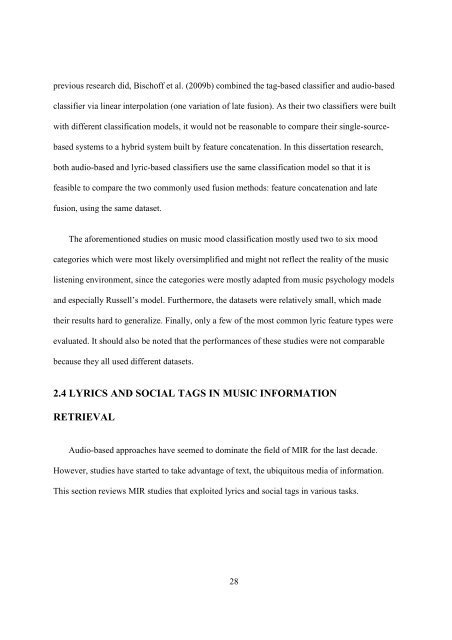improving music mood classification using lyrics, audio and social tags
improving music mood classification using lyrics, audio and social tags
improving music mood classification using lyrics, audio and social tags
Create successful ePaper yourself
Turn your PDF publications into a flip-book with our unique Google optimized e-Paper software.
previous research did, Bischoff et al. (2009b) combined the tag-based classifier <strong>and</strong> <strong>audio</strong>-based<br />
classifier via linear interpolation (one variation of late fusion). As their two classifiers were built<br />
with different <strong>classification</strong> models, it would not be reasonable to compare their single-sourcebased<br />
systems to a hybrid system built by feature concatenation. In this dissertation research,<br />
both <strong>audio</strong>-based <strong>and</strong> lyric-based classifiers use the same <strong>classification</strong> model so that it is<br />
feasible to compare the two commonly used fusion methods: feature concatenation <strong>and</strong> late<br />
fusion, <strong>using</strong> the same dataset.<br />
The aforementioned studies on <strong>music</strong> <strong>mood</strong> <strong>classification</strong> mostly used two to six <strong>mood</strong><br />
categories which were most likely oversimplified <strong>and</strong> might not reflect the reality of the <strong>music</strong><br />
listening environment, since the categories were mostly adapted from <strong>music</strong> psychology models<br />
<strong>and</strong> especially Russell’s model. Furthermore, the datasets were relatively small, which made<br />
their results hard to generalize. Finally, only a few of the most common lyric feature types were<br />
evaluated. It should also be noted that the performances of these studies were not comparable<br />
because they all used different datasets.<br />
2.4 LYRICS AND SOCIAL TAGS IN MUSIC INFORMATION<br />
RETRIEVAL<br />
Audio-based approaches have seemed to dominate the field of MIR for the last decade.<br />
However, studies have started to take advantage of text, the ubiquitous media of information.<br />
This section reviews MIR studies that exploited <strong>lyrics</strong> <strong>and</strong> <strong>social</strong> <strong>tags</strong> in various tasks.<br />
28
















